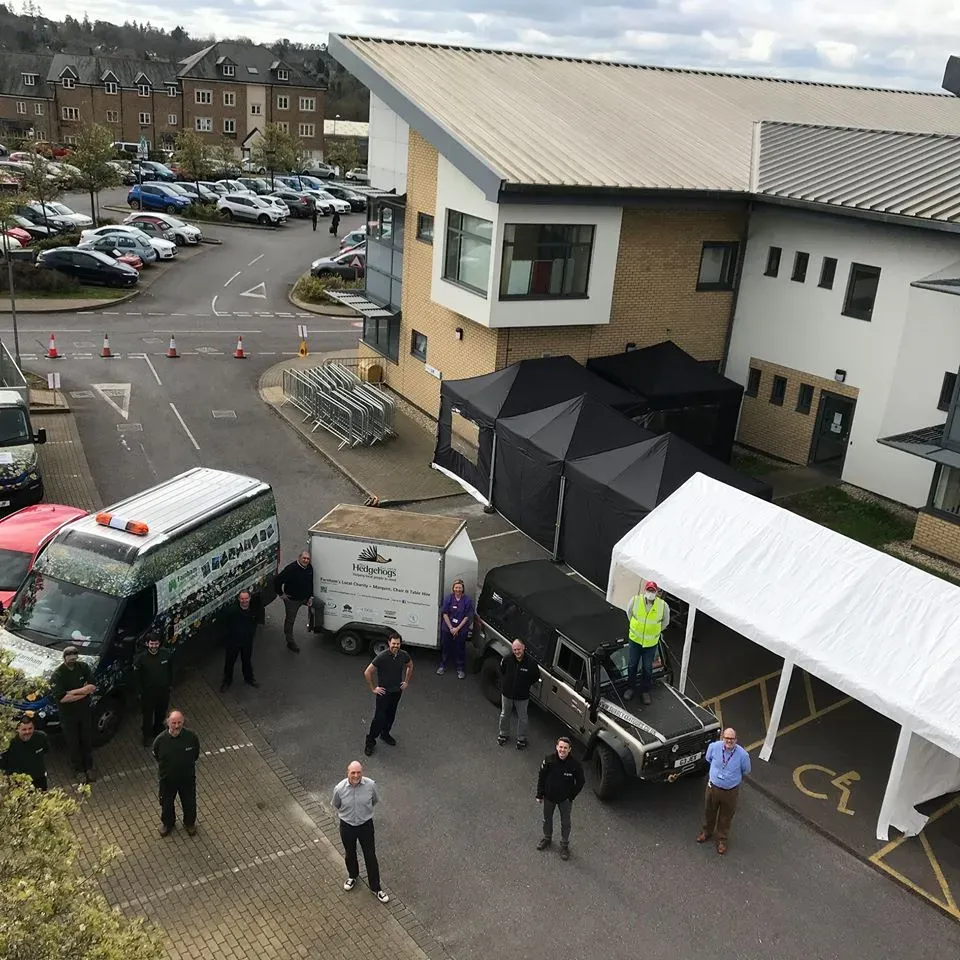Emergency Medical Tents and Shelters
Assemble in Minutes
Fully Printable Covers
Available with or without sidewalls
Explore Inflatable Shelters
Built for Extreme Conditions
Heavyweight Aluminium Framework
Industrial Strength
Explore Heavyweight Shelters
In times of crisis, having reliable, portable shelters is essential for both professionals and those affected by emergencies. Emergency medical tents and shelters provide rapid solutions for managing medical and crisis response needs on-site, offering much-needed support and privacy in disaster zones, public events, and high-risk areas. These versatile, easy-to-assemble structures can serve as temporary hospitals, first aid stations, crisis communication hubs, and more.
Why Choose Emergency Medical Tents?
Medical and emergency tents are crucial in managing and responding to large-scale or unpredictable situations. Whether for natural disasters, health emergencies, or large events, these tents offer a safe, clean, and controlled environment for first aid, triage, and even full medical services. They’re designed to be quickly deployed, allowing first responders and medical teams to establish a reliable base of operations in minutes.
Emergency shelters are not just a convenience—they are often life-saving solutions. Durable and portable, these tents are ideal for a wide range of uses, offering a crucial service where permanent structures are either unavailable or unsuitable. Their lightweight and flexible design allows for quick setup, even in remote or difficult-to-access locations. When it comes to rapid deployment, these tents are an essential resource.


Types of Emergency Shelters & Tents
Our selection of emergency tents includes a variety of styles suited to specific needs, from compact pop-up first aid stations to fully equipped field hospital setups. Here’s an overview of the main types of shelters available:
Field Hospital Tents
These large, versatile tents can be set up to provide temporary hospital facilities, complete with treatment areas, beds, and sanitary facilities. Field hospital tents are designed to accommodate several patients and medical personnel, making them ideal for large-scale emergencies and disaster response.
Rapid Deployment Shelters
For quick, on-the-spot medical and relief services, rapid deployment shelters provide a compact and efficient solution. These shelters can be set up within minutes and are designed for immediate use. Their robust build and lightweight frames allow for simple transport and swift assembly, ensuring you’re ready to respond quickly wherever needed. If social distancing measures are in place, these shelters provide a great airflow.
Pop-Up Emergency Tents
For smaller-scale needs, pop-up emergency tents offer the perfect balance of portability and functionality. These are particularly useful at festivals, sports events, and public gatherings, where they can serve as first aid tents, information stands, or triage points for emergencies. Lightweight and portable, pop-up gazebos with sides are favoured for their speed of setup and ease of transport.
Crisis Communication Tents
Information is vital during crises, and communication tents provide an essential base for coordinating with the public and emergency services. These tents serve as information points, ensuring attendees and affected people have access to resources, updates, and guidance during challenging situations.
Emergency School & Community Shelters
In disaster-hit areas, schools, hospitals, and public facilities often require temporary shelter solutions to continue operating. Car Ports have been successfully used as makeshift classrooms, food distribution centres, and temporary medical screening areas. Their sturdy structure provides essential weather protection, allowing displaced communities to gather safely.


Key Features of Our Emergency Tents
When choosing emergency tents, certain features are non-negotiable to ensure safety, durability, and reliability. Here are some standout features that make our shelters an asset in emergency response situations:
Durability and Weather Resistance: Built to withstand harsh conditions, these tents are crafted from high-quality, weather-resistant materials that can endure heavy rain, wind, and UV exposure.
Quick and Simple Setup: Designed for rapid deployment, our tents can be assembled with minimal tools or personnel, making them practical for emergency and medical professionals who need an immediate shelter solution.
Portability and Lightweight Design: Easy to transport, these shelters are lightweight and compact when packed, making them ideal for mobile operations where quick relocation may be required.
Medical and First Aid Capabilities: Our emergency tents can be outfitted with features like interior lighting, flooring, privacy panels, and additional sidewalls to create a secure environment for treating patients or offering aid.
Each of these features ensures that our emergency shelters provide a stable, effective solution for all kinds of emergency needs, from protecting patients to facilitating coordinated responses among crisis teams.

Use Cases for Emergency Medical Tents
From triage to testing, queue management, and controlled entry points, medical and emergency tents are crucial for creating safe, organised spaces in fast-paced environments. Whether for healthcare facilities, disaster response, or large-scale public events, these tents provide a flexible, durable solution for managing foot traffic, entry protocols, and essential screenings. Here’s an overview of how Gala Tent’s range of emergency and medical tents support public safety, streamline processes, and adapt to various applications.
Queue Tents for Managed Entry and Social Distancing
Effective crowd control is essential in high-traffic areas, particularly where queues are expected. Queue tents create structured spaces for organised flow, reducing bottlenecks and ensuring safe distances. These tents are commonly used at healthcare facilities, vaccination centers, and public events, where controlled entry and structured waiting areas are essential.
Key Benefits:
Organised Flow: Keeps queues orderly, ensuring that visitors are processed efficiently and reducing overcrowding risks.
Protection from Weather: Waterproof, UV-protected canopies keep people sheltered from rain and sun, making outdoor queues safer and more comfortable.
Modular Setup: Adjustable layouts allow the queue tent to be expanded or adapted to different spaces and requirements.


Employee and Visitor Screening Tents
For businesses and institutions prioritising safe entry protocols, screening tents offer a secure, private area to perform essential health and ID checks. These responsible employer tents provide a controlled entry point that helps ensure that everyone on site meets safety requirements, whether that means checking IDs, health screenings, or gathering basic information.
Key Benefits:
Privacy and Comfort: Fully enclosed sidewalls and weather-resistant materials offer a private area that’s comfortable for screenings in any weather.
Efficiency: Helps to streamline entry, making it easier for staff to monitor and control access without causing delays.
Portable and Durable: Lightweight, durable materials make these tents easy to set up and move as needed, adapting to both permanent and temporary sites.
Pop-Up Testing and Medical Stations
Medical and testing tents have proven invaluable for everything from mobile testing stations to pop-up clinics in underserved areas. These tents create a safe, accessible space for testing and medical evaluations in various locations. Easily deployed in parking lots, open spaces, or public events, they’re versatile, quick to set up, and provide the essential space needed for healthcare services.
Key Benefits:
Rapid Deployment: Pop-up design means these tents can be set up quickly, making them ideal for mobile clinics, testing stations, or temporary medical bases.
Weather Protection: Waterproof, wind-resistant canopies ensure healthcare staff and patients are shielded from the elements.
Customisable Layout: Can be fitted with partitions, lighting, and medical-grade flooring to meet healthcare requirements.


Entry and Checkpoint Tents for Event Control
Checkpoint tents allow for smooth, secure entry processes at events, construction sites, medical facilities, and other venues where controlled access is needed. While initially created to support pandemic-related protocols, these tents have become essential in various applications, from security screenings at large gatherings to routine check-ins at busy public facilities.
Key Benefits:
Controlled Access: Provides a designated area for entry checks, ensuring smooth, safe flow and screening.
Visibility: Branded or high-visibility options are available, helping to direct visitors and create a clear entry process.
Durability and Adaptability: Built to withstand frequent use, these tents can be adapted with signage, barriers, and lighting for better management at entry points.
Gala Tent offers multiple branding and printing options for use with pop-up gazebos or as standalone items, such as flags and PVC banners. With our gazebos, we offer heat-pressed vinyl printing, which is applied to our stock covers here at our South Yorkshire HQ. For printing demands that are more introcate, we offer dye-sublimation, which allows for full colour-matching, unlimited logo placements, and some serious design flair. If you're working to a strict budget then a valance banner wrap (pictured) makes for a low-cost, highly effective option. The banners are printed using high resolution graphics, and can be interchangeable as you need them. If you're using the tent to raise funds one week and then using it another week in a different way, you can change out the banners easily.
Price from: £108.99 Shop NowOther popular Gala Tent products for Emergency Services and Medical Use
Frequently Asked Questions About Medical Shelters
How quickly can an emergency tent be set up?
Our emergency tents are designed for rapid deployment and can be assembled within minutes by just one or two people, ensuring you’re operational in no time.
Are emergency tents durable enough for extreme weather conditions?
Yes, our tents are made from high-quality, weather-resistant materials, offering excellent protection against rain, wind, and UV rays to keep both people and equipment safe.
Can these shelters be customised with specific branding or signage?
Absolutely. We offer customisation options, allowing you to add branding or logos, making the tents more identifiable and professional for public use.
What sizes are available for emergency medical tents?
We provide a range of sizes to accommodate various needs, from small first aid tents for events to larger field hospital tents designed to handle high patient volumes.
Whether it’s managing queues, creating a safe entry checkpoint, or setting up mobile medical facilities, Gala Tent’s range of medical and emergency tents offer flexible, durable solutions built for challenging environments. From large-scale public events to high-demand healthcare needs, these tents adapt to support safety and efficient operations wherever they’re deployed.
 CONTACT US
DOWNLOAD A BROCHURE
REQUEST A PRODUCT DEMO
CONTACT US
DOWNLOAD A BROCHURE
REQUEST A PRODUCT DEMO
